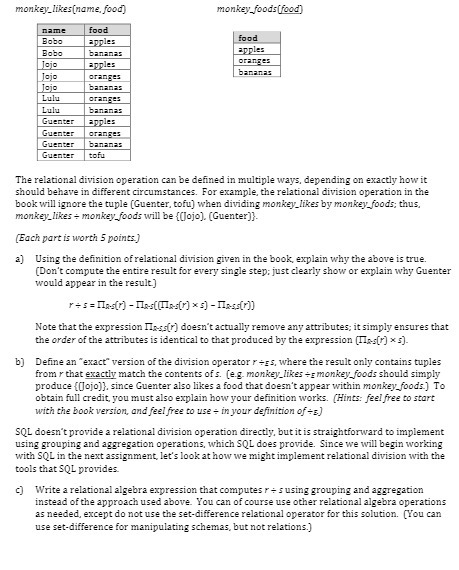monkey_likes (name, food) monkey_foods (food) name food Bobo apples food Bobo bananas apples Jojo apples oranges Jojo oranges bananas Join bananas Lulu oranges Lulu bananas Guenter apples Guenter oranges Guenter bananas Guenter tofu The relational division operation can be defined in multiple ways, depending on exactly how it should behave in different circumstances. For example, the relational division operation in the book will ignore the tuple (Guenter, tofu] when dividing monkey likes by monkey foods; thus, monkey_likes = monkey_foods will be {(Jojo). (Guenter]}. (Each part is worth 5 points.) 2) Using the definition of relational division given in the book, explain why the above is true. (Don't compute the entire result for every single step; just clearly show or explain why Guenter would appear in the result) Note that the expression Ness(r) doesn't actually remove any attributes; it simply ensures that the order of the attributes is identical to that produced by the expression (Tes(r) * $)- bj Define an "exact" version of the division operator ers, where the result only contains tuples from r that exactly match the contents of s. (e.g. monkey_likes =: monkey_foods should simply produce ((Jojo)). since Guenter also likes a food that doesn't appear within monkey foods) To obtain full credit, you must also explain how your definition works. (Hints: feel free to start with the book version, and feel free to use = in your definition of= =] SQL doesn't provide a relational division operation directly, but it is straightforward to implement using grouping and aggregation operations, which SQL does provide. Since we will begin working with SQL in the next assignment, let's look at how we might implement relational division with the tools that SQL provides :] Write a relational algebra expression that computes r = s using grouping and aggregation instead of the approach used above. You can of course use other relational algebra operations as needed, except do not use the set-difference relational operator for this solution. (You can use set-difference for manipulating schemas, but not relations.]







